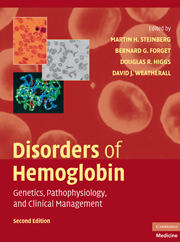Book contents
- Frontmatter
- Contents
- List of Contributors
- Foreword, by H. Franklin Bunn
- Preface
- Introduction, by David J. Weatherall
- SECTION ONE THE MOLECULAR, CELLULAR, AND GENETIC BASIS OF HEMOGLOBIN DISORDERS
- 1 A Developmental Approach to Hematopoiesis
- 2 Erythropoiesis
- 3 The Normal Structure and Regulation of Human Globin Gene Clusters
- 4 Nuclear Factors That Regulate Erythropoiesis
- 5 Molecular and Cellular Basis of Hemoglobin Switching
- 6 Structure and Function of Hemoglobin and Its Dysfunction in Sickle Cell Disease
- 7 Hemoglobins of the Embryo, Fetus, and Adult
- SECTION TWO PATHOPHYSIOLOGY OF HEMOGLOBIN AND ITS DISORDERS
- SECTION THREE α THALASSEMIA
- SECTION FOUR THE β THALASSEMIAS
- SECTION FIVE SICKLE CELL DISEASE
- SECTION SIX OTHER CLINICALLY IMPORTANT DISORDERS OF HEMOGLOBIN
- SECTION SEVEN SPECIAL TOPICS IN HEMOGLOBINOPATHIES
- SECTION EIGHT NEW APPROACHES TO THE TREATMENT OF HEMOGLOBINOPATHIES AND THALASSEMIA
- Index
- Plate section
- References
7 - Hemoglobins of the Embryo, Fetus, and Adult
from SECTION ONE - THE MOLECULAR, CELLULAR, AND GENETIC BASIS OF HEMOGLOBIN DISORDERS
Published online by Cambridge University Press: 03 May 2010
- Frontmatter
- Contents
- List of Contributors
- Foreword, by H. Franklin Bunn
- Preface
- Introduction, by David J. Weatherall
- SECTION ONE THE MOLECULAR, CELLULAR, AND GENETIC BASIS OF HEMOGLOBIN DISORDERS
- 1 A Developmental Approach to Hematopoiesis
- 2 Erythropoiesis
- 3 The Normal Structure and Regulation of Human Globin Gene Clusters
- 4 Nuclear Factors That Regulate Erythropoiesis
- 5 Molecular and Cellular Basis of Hemoglobin Switching
- 6 Structure and Function of Hemoglobin and Its Dysfunction in Sickle Cell Disease
- 7 Hemoglobins of the Embryo, Fetus, and Adult
- SECTION TWO PATHOPHYSIOLOGY OF HEMOGLOBIN AND ITS DISORDERS
- SECTION THREE α THALASSEMIA
- SECTION FOUR THE β THALASSEMIAS
- SECTION FIVE SICKLE CELL DISEASE
- SECTION SIX OTHER CLINICALLY IMPORTANT DISORDERS OF HEMOGLOBIN
- SECTION SEVEN SPECIAL TOPICS IN HEMOGLOBINOPATHIES
- SECTION EIGHT NEW APPROACHES TO THE TREATMENT OF HEMOGLOBINOPATHIES AND THALASSEMIA
- Index
- Plate section
- References
Summary
INTRODUCTION
During development, humans express six different hemoglobin types, the products of eight different globin genes (Fig. 3.1, Chapter 3). Hb Gower I (ς2ε2), Gower II (α2ε2), and Portland (ς2γ2) are found in the embryo, fetal hemoglobin (HbF; α2γ2) is present mainly in the fetus but also in the embryo and adult, whereas HbA (α2β2) and HbA2 (α2δ2) are seen primarily in adults. All hemoglobins undergo posttranslational modifications forming minor hemoglobins. Globin genes are discussed in Chapter 3, hemoglobin switching in Chapter 5, and the structure and function of hemoglobin in Chapter 6 and. In this chapter we discuss the clinical and physiological attributes of HbF, HbA2, embryonic hemoglobins, and their posttranslational modifications.
HEMOGLOBIN F
The observation that hemoglobin in newborns' erythrocytes was resistant to alkaline denaturation provided the first suggestion that a hemoglobin existed that differed from normal HbA.
Structure of the γ-Globin Genes and γ-Globin
γ-Globin chains differ from β-globin chains in either 39 or 40 amino acid residues, depending on whether a glycine or alanine residue is present at γ136. γ-Globin is the product of two nearly identical γ-globin genes. A glycine codon is present in the 5′ or Gγ gene (HBG2) and an alanine codon characterizes the 3′, or Aγ gene (HBG1). Also, a common polymorphism is found in the Aγ gene, where threonine (AγT) replaces isoleucine (AγI) at codon γ75 (HbF-Sardinia). This striking similarity in protein sequence and structure of the γ-globin genes reflect their concerted evolution from gene duplication and gene conversion.
- Type
- Chapter
- Information
- Disorders of HemoglobinGenetics, Pathophysiology, and Clinical Management, pp. 119 - 136Publisher: Cambridge University PressPrint publication year: 2009
References
- 11
- Cited by



